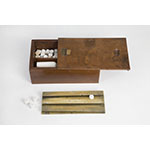Thanks to its simplicity, the pyrometer designed by Josiah Wedgwood c. 1785 enjoyed immense success in the following decades. The need to introduce physics-based measurement systems into chemistry led Wedgwood to take an instrument originally developed by experimental physicists and adapt it to the requirements of the chemical laboratory. The instrument relies on the property of clay to shrink in proportion to the rise in temperature. It was used to measure the temperature of chemical ovens. The pyrometer consists of a mahogany cabinet with a sliding lid, divided into two compartments. The upper compartment contains four small cylindrical sections and some fifty smaller pieces of dried white clay. The lower compartment contains a drawer carrying a rectangular brass plate to which three rulers are fastened with screws. The rulers are separated by two grooves narrowing at one end and designed so that, if they were placed one after the other, the second would form the extension of the first. The thermometric scale, engraved on both external sides of the two grooves, carries a subdivision into single degrees from 0 to 240° Fahrenheit (i.e., from -17.7° to 115.5° Celsius). The Museo di Fisica e Storia Naturale of Florence acquired Wedgwood's pyrometer between 1790 and 1817.









